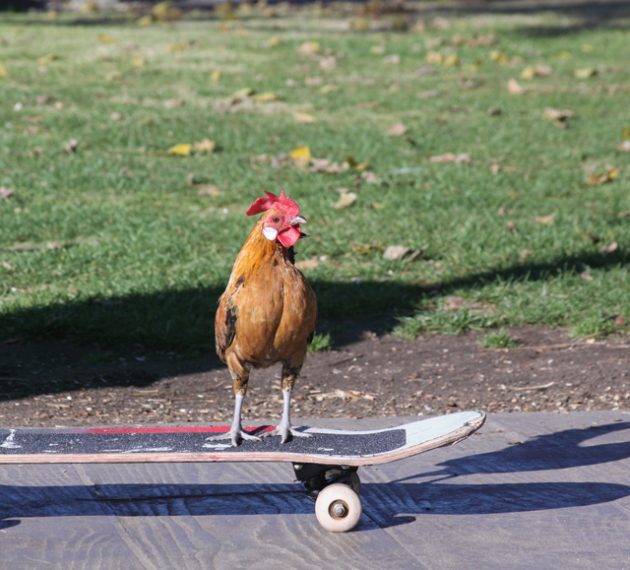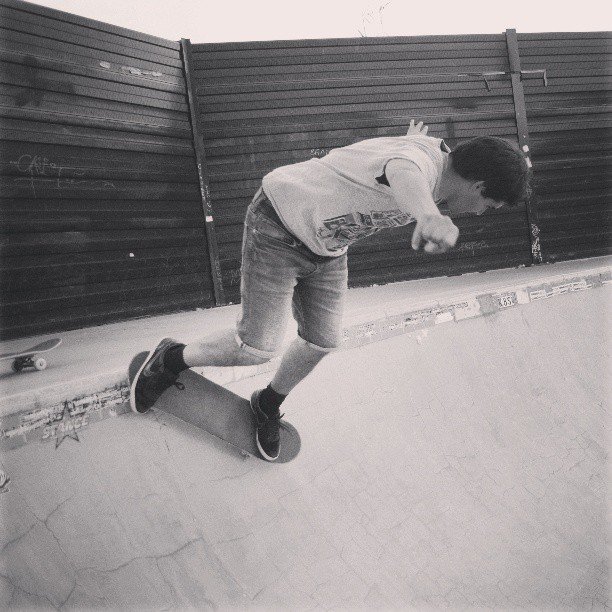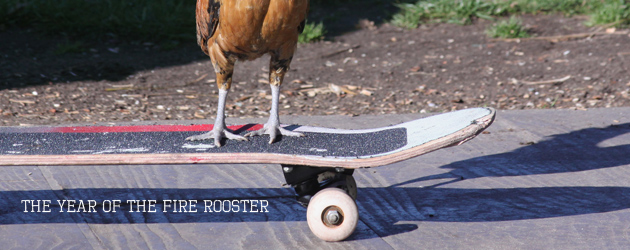
Until now, our annual round-ups have followed the blueprint: “everything’s terrible, except for skateboarding… skateboarding’s doing great”. But the winged demon eggs incubated through the previous eighteen months went and hatched in 2017, squawking white supremacist claptrap and shitting all over the soft furnishings, mixed with additional lumps of viscous misery that would have seemed far-fetched even to time-travellers from 2016’s increasingly twitchy, doom-prescient milieu. The horror of Grenfell tower within weeks of multiple terrorist attacks in the UK; and an undead British Government that failed to respond with any humanity to the former yet capitalised on the xenophobia provoked by the latter. This time, however, skateboarding seemed less than immune to all the decay and panic… not least because we lost one of our own in the terrorist attack in the London Bridge area. This tragedy said something about us and our times.
Ignacio Echeverría exhibited the quiet heroism of the best of our species, intervening to protect an injured women – facing armed terrorists with only his skateboard. His country of birth was quick to honour and remember him, posthumously awarding the Spanish Grand Cross of the Order of Civil Merit for his bravery. Skateboarders, from the Mile End community, across London and worldwide, came together with a skate organised along his last route, with a flurry of artwork, and more recently, with a skatepark in Spain dedicated to his memory. But the British Government? Slow to confirm he was missing, and even slower to provide his anxious family with vital information. An EU national and a skateboarder: characteristics sufficiently out-of-check with Brexit Britain’s now dominant narrative.

Many of our frontline politicians – our representatives who should have been first to publicly acknowledge his bravery – remained absolutely silent. Government Ministers, whose salaries we pay, were similarly tardy and disinterested when the rest of the nation looked in horror as the unthinkable happened at Grenfell Tower. Again, ordinary people of all ages, nationalities and backgrounds (and, as always, the emergency services) put themselves in danger, and then gave their time and possessions with such generosity that the storage and distribution of huge amounts of donations, with no official assistance, became an incredible logistical challenge for the volunteers on the ground. The elite at the centre become ever more removed from the multitude of confusing reality they purport to govern.
Not unlike skateboarding’s elite, corpulently bunkered down in Californian private indoor skateparks and in generously air-conditioned multi-brand action sport offices, unsure, unaware and irritated as to why skateboarding in London, Tokyo, Oslo, St Louis or rural Britain should appear more vital and relevant to the windswept masses who actually go skateboarding.
To talk of skateboarding itself in 2017, it became more important than ever to distinguish between the business of skateboarding, the act of doing it, and the community and culture of the people who do it. The business is hurting – and an influential part of it wants us to hurt too. One industry insider after another took to Instagram to curse and belittle the indie companies (I hope the excellent Lovenskate, Northern Co, Skateboard Café and Scum Co & Sons take as accidental complement their placing, alongside gender diversity, in a prominent skate artist’s ‘100 worst things’ listing). It is those (almost all white) men, those Monster-fit-wearing bros, who let in the sportswear brands, yet they claim to be corer than some cutty, unpaid skate rat who happens to wear Nikes (because they made it impossible for him or her to purchase anything else). There they are, admonishing us for ceasing to care about the umpteenth colourway of mall-ready logo-board, glossy Berrics edit, or anything that happens outside of a narrow strip of Californian real estate. Market competition is apparently well and good when it’s happening to someone else.
In other news, although to some, much of what Ty Evans has done may suck (or, to take Nick from the Palomino’s higher road, “it’s not shit, you just don’t like it”), he has it absolutely right in his Nine Club interview that the bigger ‘core’ brands may be to blame for their own decline if they regard the full-length video (the ultimate artefact of our culture, to be entombed with our kings and queens and guarded by complex traps) as mere marketing expenditure, unjustifiable if they fail to correlate with an uptick in sales. The proliferation of marketing ‘content’ has replaced works of fucking art and future touchstones of our youth and young adulthood. The Skateboarder Magazine has been killed so the Berrics Magazine can replace it (non-consensually absorbing subscribers and Instagram followers to the understandable chagrin of those who’d invested in the former mag out of actual informed choice). More ephemeral content. The newer, smaller brands, with the freelance auteurs they work with (Josh Stewart made the new Traffic video, which is just a perfect turn of events), are capturing both the imagination and spending money of the kids and veterans alike, because they come from an authentic place that is more about solemn ritual (videos are what a skate company ‘should do’) than product placement. Some bigger brands know this too, of course, Real and Crailtap among them, and it’s nice to see Real’s strong, politically-charged 2017 board art placed alongside the upstarts in the Ripped Laces’ review of the year’s best graphics. Seriously, if you’re among those who argue that the newer companies ‘add nothing’ to skateboarding, open a skate mag from the mid-2000s, when the bigger brands reigned supreme, flick to a page full of their deck ‘graphics’, and then compare it to today’s skate shop board wall.
But because the devil is now well and truly in the room, many of the videos from today’s insurgent indie brands, though largely self-financed, are endorsed and co-branded by the sneaker companies slowly murdering the very same ma and pop skate shops that stock and premiere the darn things. So we exist in an insane dichotomy: the 20-30 year deep ‘core’ brands feel compelled to churn out only throwaway web edits; whilst the new upstarts produce the meaningful stuff we care about… Except with a swoosh or 3 stripes somewhere in the end credits. And no one is getting paid.
On that note, let’s see if Nike’s dedication to building more skateparks or indeed supporting their existing current batch of parks continues in Europe throughout 2018. Most brands abandon these sorts of projects after 4 years so we are watching closely. (-Z)
Yet there are shards of light amidst the clouds, as there always are. DC made a fucking skateboard video. And it was good; and not just because of Tiago Lemos. Alex Olson’s 917 unexpectedly dropped a full length with little fanfare, that divided opinion, but – on balance – was more rad than otherwise; and Krooked followed with a highly enjoyable 20+ minutes that ignored two decades of filming progress, convention and consistent aspect ratios, and was no poorer for it. But 2017 was really the year for British and Japanese skateboarding, as Skate Twitter (shout out to all 15 of you….) has proclaimed more than once. And also for Australian skateboarding (and New Zealanders skating in Australia), with Melbourne becoming a global skate destination that is starting to stand alongside the NYC-Barcelona-Copenhagen-Berlin-Paris-London skate tourist lock-down.
Highlights from the UK included Jacob Harris’ continuing ‘Atlantic Drift’ series and Quentin Guthrie’s ‘Next’, which followed up his equally great ‘Brexit’ with a banging section from a personal favourite and new Skateboard Café acquisition, Dom Henry (I’ve studied the skating of Kalis, JB, Daniel Lebron, Baines, etc. for twenty years, to sub-mediocre effect – Dom nails it, with aplomb, at almost ten years my junior. Bastard). With reference to Atlantic Drift, just now on its sixth episode in 12 months, it can’t got without comment that this was one of the many series and standalones of the year (alongside other indie offerings, including sections from the final episode of the Sabotage vids) to be premiered, hosted and co-branded by Thrasher – marking the year that ‘The Bible’ became ubiquitous in online skate media (eclipsing the Berrics and standing high above the ashes of the now defunct Ride Channel).
One of the most memorable, distinctly British, offerings came in the form of Jim Craven’s high concept ‘Island’, that eerily charts a small group of skateboarders’ journey from Land’s End to John O’Groats, wild camping and skating isolated spots of melancholic rural solitude. It’s reminiscent of the 2013 Carharrtt WIP x Antiz ‘Swiss Banks’ edit, but a more compelling watch. Perhaps lower profile, but well worth uncovering, was Bristol’s OWL skateboards’ UTOPOS, whose team reject the ‘easy’ option of plaza or chiller spots, choosing instead the grimy by-ways of the British post-industrial wasteland, and wearing on their sleeves their obsessions for the writing of Orwell, Huxley and Ballard and the utopian socialist architects and town planners associated with New Brutalism. Together, the two edits capture starkly contrasting rural and urban takes on the uncanny eeriness to be found in our grey-skied lands.
Before moving eastwards, a very different take on Britishness. Palace’s double-hit for 2017, opening a free indoor, 90s Radlands-recalling ‘Mwadlands’ park and suddenly releasing their first full length, Palasonic, reminded our corner of the world that they are, first and foremost, a skateboard company – despite having expanded from relatively niche hypebeast catnip into the wardrobes of almost every Home Counties teenager (I teach in a large university and, without exaggeration, at least one in every three white males in any given seminar group will be wearing a Palace-branded item). It says something of Thrasher’s success that they’ve grasped what others have not – skateboarding has finally gone very global, and in doing so it has diversified. They may have awarded SOTY to an All-American, heartily-built rail chomper, but other nominees included Europeans Oski, Daan and Palace’s Lucien Clarke – on the back of his Palasonic section (complete with Toby Shuall tribute gratefully noted by appreciators of Chris Massey and Mazzy Star).
Over to Japan, much of the autumn was spent in anticipation of home-grown brand Evisen’s debut. Those sections shared on, who else, Thrasher, did not disappoint – with Seimi Miyahara distilling all that is eye-poppingly unique about the scene and its skaters: lightning quick feet, precise flatground execution, fearless pop, and creative approaches to distinctly odd obstacles that require all those things, invariably filmed at night out of expediency, but providing that nostalgic Mixtape feel amongst the new and weird. You can watch the sections and buy the video from Nick.
Along with London’s ascendancy to NYC based-zeitgeist hunter’s wet dream, the Evisen video throws up interesting questions as to what makes a scene cool? Japan has always been cool to Western skate eyes – due in no small part to the Orientalising exoticism we continue to project upon the place and its people – but of 2017’s rise of Australian skateboarding? The Antipodean Canada of skateboarding: assumed to be all XXXL t-shirts, fitted caps, and fucking Globe shoes, despite producing skateboarders who are better per capita than most Americans and Brits. As in the case of Canada in 2016, several Australian brands came of age in 2017 and several amazing scene vids showed us what idiots we are. And Sports Class produced one of the coolest edits of the year that wasn’t even filmed in Australia.
The final, perhaps biggest victory for 2017 was won by female skateboarders, with brand after brand turning the women on their roster pro. This included ever-late-to-the-party bigger brands, like Plan B with Leticia, although that barely compensates the terrible women-hating, Islamophobic, homophobic things said or shared by the online persona of one later career Pat Duffy – please let it be a Putin bot (props on spotting it, and consistently calling it out, to Thom Callan – we don’t give present-day Morrissey a pass for the terrible things he blurts about Englishness because of the music we love, nor should Duffy get a pass because of what he once achieved on a skateboard).
Pundits celebrated the names on boards of the aforementioned Ms Bufoni, then Nora, but forgot that Weekend gave Alexis Sablone a board towards the start of the year whilst upstart Swedes Poetic Collective had never thought to draw a distinction between its male and female riders, with Sarah Meurle’s name on a board in their earliest days as well as creative agency over what it looked like – to stunning aesthetic affect. Take note you few remaining balrogs who can neither break the bro-down nor crack out a decent board graphic. Warm feelings all round when long-time ripper Lucy Adams’ board on Lovenskate was accompanied by a rad video part, but our progress also stalled with the internet backlash to Lacey Baker’s incredible section, prompting Anthony Pappalardo’s intelligent piece for Kingpin (the writer, not the Alien alumnus) spotlighting skateboarding’s persistent issue with bigotry. Before commenting angrily that there isn’t, and has never been, a problem with gender or sexual orientation in our world, skim the Facebook thread on Lacey’s section (and threats to unsubscribe from Kingpin beneath Pops’ article) and get back to us. The idea that we’re holding women skaters to ‘performance’ criteria (stair count, rail height), whilst 90% of sponsored male skaters are variously appraised on the basis of style, taste, creativity, spot-selection, etc., is absurd. If all male skateboarding is held to those quantitative measures, we’d be much poorer for it. And, as in wider society, there’s always an evaluation according to the sexualised male gaze, a gaze that will either objectify or find fault: Lacey is insufficiently feminine, Leticia is too overtly so.
The section that made the biggest impression on me, out of the incredible number from female skaters in 2017, was Alexis Sablone’s Welcome to Weekend. I loves me a snapped flatground flip, and Alexis represents much that is rad within and beyond skateboarding (a resilient East Coaster, an architect, a thinker, with that Kerry Getz or Dave Mackey power push). All this contrasts with, and shows the path to leaving the white/Californian/middle-aged/apolitical/commodifying/male cartel alone to their prolonged ten-year death rattle – as Bertolt Brecht then Walter Benjamin once implored us to erase the traces, build the new, exorcise the detritus, finally enter the 21st Century, albeit 18 years late.
Words: Chris Lawton
Finally a shout out and thanks to Rollersurfer on IG. Long may his quirky missions continue. (-Z)
If you would like to write for Crossfire this year then get in touch.
